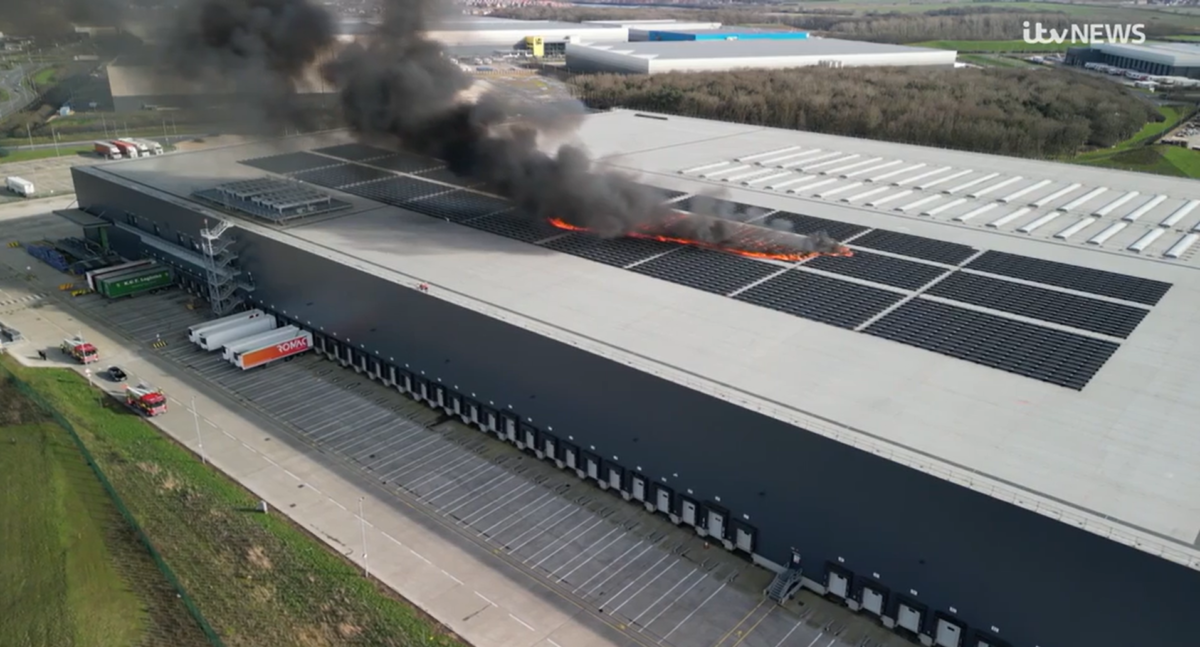
Ensuring Safety in Cold Chain Federation Solar PV Projects
This latest blog post about the importance of fire safety in solar PV projects comes from Nick Spicer MD at Your Eco.
The Cold Chain sector plays a critical role in maintaining the integrity of temperature-sensitive products, ensuring their safe storage and distribution. As the demand for sustainable practices grows, many members of the Cold Chain Federation are turning to solar photovoltaic (PV) systems to power their facilities. However, when it comes to solar PV projects, safety must be a key factor at the fore of considerations when implementing such technology.
To drive this home, only last Friday did a solar panel fire break out in Peterborough at one of Lidl’s warehouses, which, when built in 2020, had solar fitted as part of the construction. The cause of the fire is unknown, but it raises questions about how this came about, be that through the physical installation of it or the technology used within. What is clear is that with the risk being further highlighted and playing out, insurance firms are also starting to ask the question and look at this themselves in relation to building policies. This is something we at Your Eco have seen on the increase over the last year, with us being asked in several cases to upgrade the existing solar to what is cited as a safe solar system.
In the USA this has gone further still with electrical regulations in the form of NEC (National Electrical Code) 2017 setting out the need for rapid shutdown and low voltage system functionality. The UK currently doesn’t have such regulations in place and nor are such technologies required within the solar sector. That being said, with it only really having been mainstream now for a decade as a sector, and without well-trodden paths for technical and professional development, much of the learning and technology in solar is driven by experience as opposed to being legislation driven.
This area of safe systems is, for reasons now clear, becoming of much greater significance and with discussions being had across the industry. That being said, there remains no clear mandated direction; hence, without clear policy or requirements, installers will follow what little regulation there is currently, and that which also enables low barriers to market entry.
In looking at what, therefore, can be done to ensure your system is both safe and future-proofed, much of the discussion is focused on rapid shutdown and the ability to isolate a system at a module level on the roof. However, competent installers delivering systems at an individual level, not just as companies, also need to be a determining factor with a strong quality assurance process in place. This goes through to demonstrable evidence that systems have been installed in accordance with the manufacturer’s guidelines and the underlying documentation trail that brings this all together.
Technology wise, arc fault detection within the inverters should be installed as a minimum qualifying criteria. This enables the early detection of arc faults in the PV system and significantly reduces the risk of electrical fires by identifying potential hazards before they escalate, often shutting strings down as a precautionary measure.
Should a fire or issue manifest, then module-level rapid shutdown of the system, and having this tied into the existing fire system is of great benefit, explicitly called for by NEC 2017 690.12. The stipulated guidelines by this edition is that it requires the voltage and current be reduced to no more than 80 volts and 240 volts-amperes within 30 seconds of initiating a shutdown command.
There is also a need to consider what is called for in module level isolation whereby any risk is shut down at the individual panel level, as opposed to the string level, whereby the latter will still have the ability in an emergency to pass current down the DC cables that connect the panels to the inverter(s). The route and length of DC cable run is an important factor in this instance, noting that without module level isolation, there is the risk that any potential fire and fault could pass through the extent of that cable route. Depending, of course, on that routing, that could create additional hazards throughout the building.
There is, however, good news in that all of these criteria can be met without significant additional costs in using optimised technology and micro-inverters. It is why as a business at Your Eco, we only install SolarEdge technology, one of the global market leaders in inverter technology. Listed on NASDAQ and with over 50% of Fortune 100 companies using SolarEdge on their rooftop assets, you can see why this decision has been taken.
SolarEdge as a product offers rapid shutdown and a low voltage system, affording module level isolation and being fully compliant with all electrical standards such as NEC 2017. To the extent that as a stipulation, we are increasingly seeing this technology stipulated for its enhanced fire safety characteristics on new build construction projects and even by insurance firms, a trend I suggest that is likely to increase.
In installing optimised technology such as SolarEdge, members of the Cold Chain Federation will be building solar systems that mitigate fire risks, whilst complying with potential future enhanced electrical guidelines and uplifted insurance specifications. Solar PV will continue to be part of the net zero transition and play a leading part in the low carbon energy mix and carbon reduction strategies, and in rolling out this technology, we need to ensure we are building safe and enduring bankable assets.
You can learn more about Solar Edge and Your Eco on their website.
Contact Your Eco on [email protected] or 01225 931666 to help boost production, analyse safety, reduce cost, and step towards sustainability with renewable energy.
References;
https://knowledge-center.solaredge.com/sites/kc/files/rapid_shutdown_in_solaredge_systems_row.pdf
https://knowledge-center.solaredge.com/sites/kc/files/safety-flyer-nam.pdf
Comments are closed.
